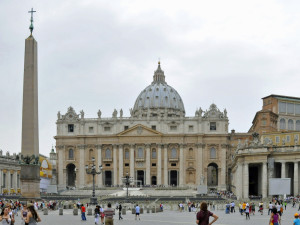In 319, newly Christian Roman Emperor Constantine ordered a massive basilica built over a small shrine in a cemetery adjacent the Circus of Nero. Local Christians claimed the shrine marked the grave of Peter, the disciple of Jesus they believed was crucified in 64 A.D. near an obelisk, plundered from Egypt, near the center of the circus. Constantine’s church, named for Peter, became one of the most important churches in Christendom.
In 1505, the original St. Peter’s had fallen into disrepair and Pope Julius II decided to build a new basilica on the site. Numerous designs, all including a dome surpassing Brunelleschi’s astounding dome on the Florence Cathedral, were proposed by a series of noted architects, including Rafael. For various reasons, those designs were never built. In 1547, a frustrated Pope Paul III conscripted Michelangelo, then 72, to take over the project and he is credited with creating the overall plan for the current building. In 1586, with construction underway, the obelisk from the Circus of Nero was placed in front of the basilica as a tribute to Peter, with a cross placed atop an apex designed to point toward Egypt’s sun god. Completed in 1626, St. Peter’s Basilica encloses almost five acres. The signature dome rises 448 feet, 160 feet higher than the United States Capitol dome.
Today, the body of Pope John XXIII is displayed behind glass on the main floor of St. Peter’s and that of Pope Saint John Paul II is entombed near Michelangelo’s famous pieta. They join at least 89 other popes buried in and under the church that Roman Catholics since Constantine have believed lies over the tomb of St. Peter. In the 1940s, archaeologists uncovered a handful of bones beneath St. Peter’s main altar later determined to belong to a man in his 60s. The faithful have no doubt the man’s name was Peter.

Comments are closed.